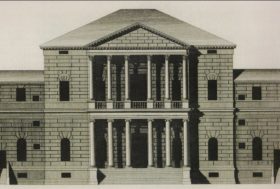30 September 2014 – The Amsterdam architect Gus Tielens invited me for a talk at the Amsterdam School of Architecture last Friday. Gus asked me to tell about the everyday fascinations within the studio. This question was never asked before. I do get asked a lot to show so called ‘reference images’. In these cases fascinations have an objective. They should clarify something and they have to convince.
All that was not required in Amsterdam. I showed holiday pictures and images that I made during my stay in Cambridge. All buildings and urban sceneries shown were almost monochromatic and made from stone and brick. They were images of slowly extended and changes buildings and cities in which style differences were –so to speak- ironed out by the use of materials. Naturally, the reason for that is the local availability of materials. In this way Dijon was constructed as a beautiful city centre in stone. It is very homogeneous in colour and material, but very divers in texture and style. On second glance Dijon is the backdrop of a collision of diverging kinds of bigger and smaller architectonic interventions from different times.
In painting one would call the nuances that result from small differences in texture and colour shades a ton-sur-ton effect. I showed the students how in different projects I have related a restrained material pallet to the context in which I worked. Today that is not self-evident because all construction materials are available always and everywhere. Such simplicity is now the result of a conscious decision and not of a limitation in availability of materials.
In my talk I compared the etch of a classicist villa designed by the architect Andrea Palladio with a contemporary analytic drawing of the same villa. The etch is in black and white. Very precisely the shadows have been rendered. The difference between tiny jumps in the relief and the strong plasticity of the façade appears clearly. The drawing very clearly demonstrates that the columns of the portico are circular in plan. The joints of the stone blocks are drawn as if they are part of the composition. This masterpiece was not about the montage of all sorts of form motifs, colours and materials. The analytical drawing by contrast is colourful and tries to catch the design in a singular concept.
That seems to me the paradox of contemporary architecture. Colourful drawings communicate singular concepts. A more restrained architecture give rise to multiple experiences of the urban context.
